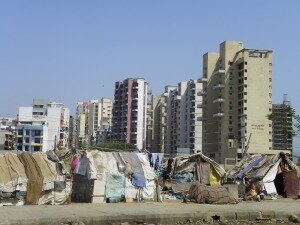 |
The birth of Youth for Unity and Voluntary Action (YUVA), a voluntary development organisation, in the year 1984 marked the beginning of a journey of empowering the oppressed and marginalised in urban areas and later in rural areas. Since 1984, YUVA has questioned social structures along the side of the poor, with the aim of empowering them to participate in a process of meaningful change.....Read More>>
|
| News and Programme Updates : |
|
The Development Plan of Mumbai The Development Plan of Mumbai is up for review and revision .The Development Plan or DP, to put it briefly, lays down policies on how the available and existing land should be distributed anticipating future development of the city. The DP is to take into account the needs of the population and infrastructure needed for Mumbai such as housing, transport, sanitation, environmental management and beautification of the city. The Development Plan was first made in 1964. In 1966, the Maharashtra Regional and Town Planning Authorities converted the DP into a Regional plan for the future development of the city, suggesting a 20-year planning period. In the period of 1991 to 2012, Mumbai’s demography has changed faster than expected. The number of people coming into the city to earn livelihood rose from 3.7 million in 1991 to 5.2 million in 2000, with 60 to 70 percent of the population living in informal settlements. This large section of population is not only an important source for cheap labor but also major contributors in the development of the city of Mumbai. Yet, 92% are employed in unorganized sectors without any security of livelihood and shelter. As Mumbai’s needs become increasingly complex, the majority of Mumbaikars remain invisible on the city’s development map, with neither their settlements nor their workspaces adequately represented in the DP. Incorporating these realities into urban planning calls for a nuanced approach, one that could serve as a compelling topic for an architecture essay writing service, exploring the intersection of urban design, social justice, and sustainable development. The 12th Schedule of the 74th Amendment Act of India defines 18 new tasks in the functional domain of the Urban Local Bodies. These include planning for economic and social development, safeguarding the interest of the weaker section including the differently abled, and slum improvement and up gradation, amongst other things. Youth for Unity and Voluntary Action (YUVA), for the last 29 years, has been advocating for the Right to Shelter and Livelihood for the urban poor. Our ground experience suggests that the poor have always been excluded and isolated from participating in the planning process. This highlights the need for ordinary Mumbaikars, especially the urban poor in Mumbai, to understand the relevance of Development Plan in their lives and how they will be able to participate in its planning and implementation. In order to promote people’s participation in the planning process, YUVA has carried out awareness programs on the Development Plan in partnership with local CBOs and NGOs in five (5) other wards (M-east/west, L-east/west and K-west). A staggering 70 percent of the city population (women, children, homeless, pavement dwellers) and the Koli community’s lives will be greatly affected by the DP. It is therefore imperative that their views and demands are placed before the local authorities and they be made participants in the planning process. In a series of press clippings starting (16 January 2013), we bring to you some of the observations made by YUVA and other civil society organizations in highlighting the biases and errors in the existing land use (ELU) survey carried out by the Mumbai Municipal Corporation in the run up to the preparation of final Development Plan of Mumbai...Read More>> |
|
Basic Service Facilitation Centre (BSFC)
Basic Service Facilitation Centre "Astitva" at New Babrekar Nagar, Malvani , Malad (W) was inaugurated on 8th January 2013 by the MLA, Aslam Shiekh...Read More>> |








